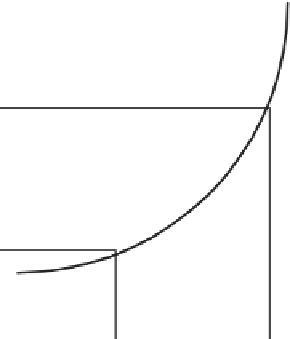Geology Reference
In-Depth Information
f
i+1
f
i
f
i-1
x x x
i-1 i i+1
Figure 4.2.5.
Finite difference discretizations.
Taylor series analysis shows that Equation 4.2.58 for the second derivative
is
second-order accurate
in
x. The O(
x)
2
describes the order of the
truncation error; if
x is
small
, then O(
x)
2
may be regarded as being
very
small
. Likewise, it can be shown that
df(x
i
)/dx = {f
i+1
- f
i-1
}/(2 x) + O( x)
2
(4.2.59)
for the first derivative, is second order accurate. Equations 4.2.58 and 4.2.59 are
“central difference” representations for the respective quantities at x
i
because
they involve left and right quantities at x
i-1
and x
i+1
. Note that the “backward
difference” formula
d
2
f(x
i
)/dx
2
= { f
i
- 2f
i-1
+ f
i-2
}/( x)
2
+ O( x) (4.2.60)
for the second derivative is
not
incorrect. It is not as accurate as the central
difference formula, since it turns out to be
first-order accurate,
the error being
only
somewhat small
. Similar comments apply to the “forward differencing”
d
2
f(x
i
)/dx
2
= { f
i
- 2f
i+1
+ f
i+2
}/(
x)
2
+ O(
x)
(4.2.61)
Alternative representations for Equation 4.2.59 are the backward and forward
difference formulas
df(x
i
)/dx = {f
i
- f
i-1
}/
x + O(
x)
(4.2.62)
df(x
i
)/dx = {f
i+1
- f
i
}/ x + O(
x)
(4.2.63)
























Search WWH ::

Custom Search